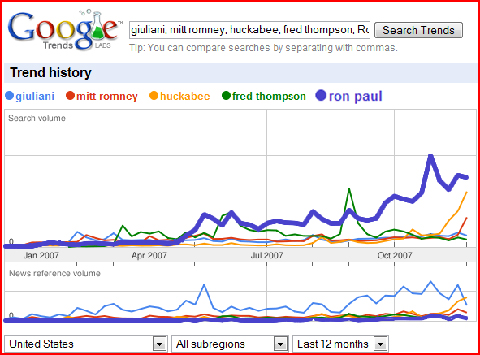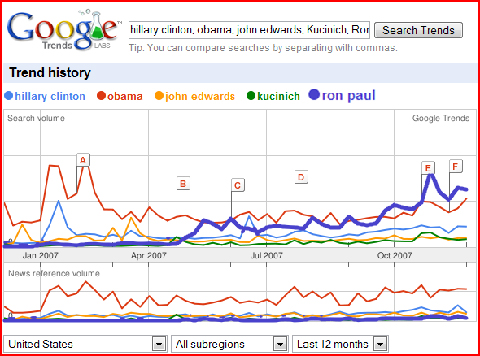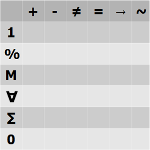My Prediction for the 2012 Presidential Election
Is Romney revolting? Is Obama offensive? Was Ron Paul prevented? I predict most people will be unhappy with the 2012 Presidential election. But there is a cure.
Predicting most people will be unhappy is simple math. Polls show a very tight race between Romney and Obama. If the country were perfectly divided then half the people would be unhappy with the decision. Since there is a substantial amount of people who want someone other than those two that means the majority of people will be unhappy with the result of the election.
What is the cure? More alternatives! No, not more candidates. Electing any one person causes a win lose situation. That will always result in someone being upset and quite often the majority will be unhappy with the result. The cure is more alternatives than electing a president.
Amazingly there are 1,296 alternatives related to any choice. I suspect you never realized those 1,296 alternatives even existed.
The 1,296 alternatives aren’t political parties or even candidates. No matter who is selected for president it’s the same type of choice. It’s a choice for someone else to make your decisions.
To make matters worse, you don’t even get to choose who chooses for you.
Let that sink in a bit. Every decision at the federal level and most decisions at the state and even local level are made by someone other than you. Not only are those choices made by someone other than you, it’s someone who doesn’t even personally know you. How in the world do you think they’ll choose what you want?
The cure is simple, choose a different set of the 1,296 alternatives. So, what are these 1,296 alternatives?
For any decision there is who makes the decision and the actual decision itself. Each of those can be further broken down into categories of 6 Directions and 6 Scales. The 6 Directions and 6 Scales form a grid of 36 Alternatives. The combination of 36 Who Decides and 36 Decisions forms a total of 1,296 Alternatives.
Lets examine Who decides to get a better understanding of the Alternatives.
6 Scales for Who Decides:
- Single 1: One person or type of person decides. Example: individual decision.
- Partial %: Some people decide. Example: Voting where a % makes the decision.
- Multiple M: More than one person required to make a decision. Example: Having a baby requires two people.
- Any ?: Anyone can decide. Example: Freedom, choices over your own property.
- All ?: Everyone required to decide. Example: Criminal jury trial, all 12 members must agree to convict.
- None 0: No one decides. Example: Left to chance. Decision is prohibited.
6 Directions for Who Decides
- Direct +: The person or people directly involved in doing or benefiting from the action make the decision. Examples: personal choice, buying something for cash.
- Opposite -: Decided by a person or persons who oppose the action or who will be harmed by the action. Example: veto.
- Other ?: Someone other than the person it affects. Example: government official.
- Same =: Person stays the same or person is neutral. Examples: Life time appointment. Judge.
- Stabilize ?: Starts as a different alternative before stabilizing: Example: tie breaker.
- Changing ~: Person who decides changes. Example: taking turns deciding.
President is a Single Other Alternative. Other examples of Single Other are: parent, boss, or criminal such as a mugger or rapist.
Nearly all elections in the USA are Partial Other. Either through the party system, or ballot access rules someone else has filtered your available choices.
Supposedly everyone is allowed to vote but people under 18 are not allowed and in many states prisoners are banned from voting. Also people without a fixed address or who split their time between places are only allowed to vote in elections in one place. That means they are prohibited from voting on issues or officials who affect their lives.
So all elections in the USA are Partial Other. That means only 2 of the 36 Alternatives for Who Decides are even offered as choices. That is less than 6% of the Alternatives for Who Decides.
Who Decides isn’t even the most important choice. What you really care about is the actual decision. Again there are 36 Alternatives for the Decision.
6 Scales for Decision
- Single 1: Single decision. Decide once.
- Partial %: Partial decision. Sometimes decide.
- Multiple M: Decide on many things. Decide many times. Multiple alternatives to arrive at decision.
- Any ?: Any option is possible. Decide anytime.
- All ?: All options without compromise. Everything you want. Always decide, not left to chance. Continuously. Continuously decide, moment to moment.
- None 0: Never decide, leave up to chance. Decide to never do it.
6 Directions for Decision
- Direct +: Decide for action. Decision directly connected to the action.
- Opposite -: Decide against action. Decide for opposing action. Decision causes opposite action.
- Other ?: Decide another choice. Action caused `by a different decision.
- Same =: Don’t change existing. Neutral choice. Same choice.
- Stabilize ?: Decision stabilizes. Becomes decision. Starts undecided or as a different decision then becomes the final decision.
- Changes ~: Decision changes. Effect of the decision changes.
Decisions made by government almost always are Single Direct decisions causing You to Pay More Taxes or Single Opposite denying your right to do something. The decisions are single because most laws are never repealed.. So again only 2 of the 36 Alternatives. Combined with Who decides only 0.3% of the Alternatives are ever offered. No wonder so many people complain about government.
Out of 1,296 possible Alternatives 99.7% are ignored.
The 1,296 Alternatives don’t only apply to politics, these are the Alternatives for any decision. This forms the basis of business strategy. The goal of innovation is to satisfy unmet desires. Understanding all of the decisions potential customers can make gives you a significant advantage.
Ron Paul Revolution: History in the Making. My new book.
My new book is just released. It goes into great details about what is driving the excitement for Ron Paul and how Freedom is the Ultimate Product for Evangelism Marketing.
During the pre-primary campaigning I’ve been able to meet Ron Paul and consult with the official campaign. I’ve been able to see the inner workings and I’ve been all over the world with the grassroots. Ron Paul’s success is a perfect example of evangelism marketing and the abundance society at work. Ron Paul’s campaign is the epitome of evangelism marketing. None of the success has been from anything the national campaign has done. The fund raising, the signs everywhere, the posts all over the Internet are all from individuals acting on their own to promote the idea.
Factors like the Long-Tail as described by Chris Anderson of Wired Magazine have enabled Ron Paul’s supporters to set records for fund raising. Open Source techniques are being used to propel ideas into action and even fund $300,000 projects. This type of free innovation overcomes the scarcity economics.
Few people understand what is going on with the Ron Paul campaign, not the media, not the competition, and not even Ron Paul’s staff. The new culture based on abundance is taking hold and its powered by freedom. I’ve talked with the top staffers in Ron Paul’s campaign many times, and even Ron Paul himself. They don’t have a clue about evangelism marketing, they just know something is working. I can only imagine how big this campaign would be if they had implemented the 22 elements for a complete evangelism system. Ron Paul himself does do the most important thing, he tells the truth.
Many of the 22 elements of a complete evangelism marketing campaign have been implemented by supporters. That is the power of evangelism, abundance and freedom.
Here is a sample chapter.
The Largest Minority
The industrial revolution focused on mass marketing. Success was achieved by making common items in the most cost efficient manner to sell to large groups of people. Standardization was the hallmark of the 19th and 20th century, but as the Information age emerged it became possible for the universal truth of individuality to move to the forefront. The potential for mass customization became reality and is totally revolutionizing every aspect of life. Oddly enough the information age, re-popularizes the ideas codified 230 years ago in the Constitution of the united States of America. The individual is King.
The Ron Paul Revolution benefits from a phenomenon described by what publisher of Wired magazine, Chris Anderson, calls “The Long Tail” In his article in Wired Magazine and his book of the same name, he pointed out that 98% of the Top 10,000 books carried by Amazon.com sell at least one copy per month. That means there is a market for every imaginable subject.
Ron Paul Viral Marketing Success
Ron Paul is winning popularity portion of the united States presidential election. He consistently speaks the truth and does what he says. And lucky for Ron Paul the truth makes a lot of people so happy they sell his message for him.
I pioneered viral media on the web. And have since moved beyond viral to a broader more accurate term, evangelism. Its clear Ron Paul has a lot of evangelists. All of his success is from normal people spreading the message all on their own.
Part of my research on viral / evangelistic marketing is what the trends mean and how to get the results you want. Looking at the trends for Ron Paul and the other candidates I see some very striking results.
Google Trends is accurate unbiased data on what real people actually care about. According to Neilsen/NetRatings 232 million Americans use the Internet. That makes Google Trends the largest most accurate measure in the world.

First, Ron Paul (dark blue line) has more searches than than any other candidate. Plus his searches is continually growing. This is suggestive of real wide spread support. There are 7.7 million pages on Google for Ron Paul.. That is almost 4 times as many as Mitt Romney. Ron Paul has more pages about him, which confirms support not just interest. There are other measures I use and will explain those in future posts.
Romney (orange line) has no real support. You can see this from how his traffic jumps then immediately falls to nothing. He depends on events to get any interest. If Romney was a company I would short his stock. His advertising works but Romney is a bad product.

Hillary Clinton (the red line) is suffering from the same problem as Mitt Romney. She gets big spikes but people don’t like her and try to forget her as soon as possible. Even with a huge budget and over 16 years of national media attention there are only 5.8 million pages talking about her. And much of that is criticism. Hillary Clinton is the political equivalent of Paris Hilton. She gets attention when she does something insane but loses popularity every time.
Barack Obama is in bad shape. Notice that he got a big jump when he announced he was running for office but his traffic has consistently gone down. With only 2.8 million pages and downward trend Barack Obama he is far behind the leader, Ron Paul. The fact Obama doesn’t get any new jumps means its unlikely he will gain any support. He could linger around for a long time but will have a hard time getting new attention. He is played out.
My Suggestions
Hillary has total name recognition. Since people react so negatively she can’t really benefit from Evangelism Marketing without doing something very different. With her long track record she would face the credibility issue if she tried to be different. She depends on spending huge amounts of money and favorable treatment from the big press to get attention.
Romney is dead in the water. He needs to find something unique that he actually deliver. Unfortunately that would require going back in time. He can’t deliver anything unless elected.
Obama can make it to the election with his current trend. He needs to find a new audience, which is unlikely since he already had a huge jump in the beginning. If he offers something new that might get more attention.





 Predictive Innovation Training
Predictive Innovation Training Predictive Innovation: Core Skills Book
Predictive Innovation: Core Skills Book RoundSquareTriangle.com
RoundSquareTriangle.com